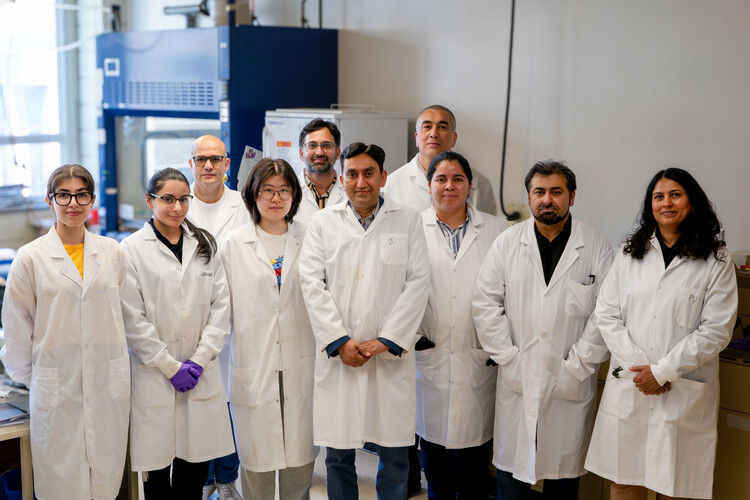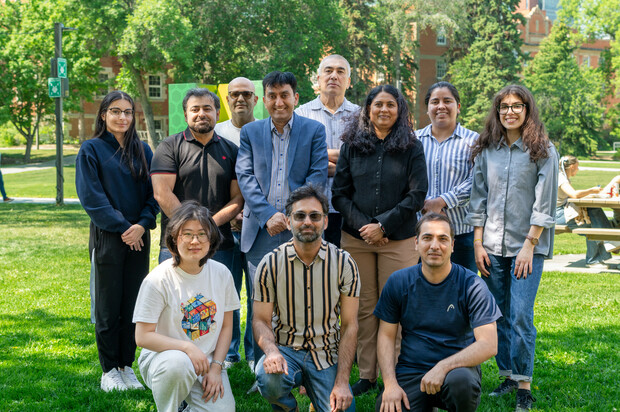The Project Report: Decontaminating Water with Chicken Feathers
Posted on
Dr. Aman Ullah, in the Department of Food & Nutritional Sciences at the University of Alberta, is pushing the boundaries of his food science foundations for water treatment solutions. For the past 15 years, Aman and his team have adopted a circular economy approach to develop water treatment techniques using a material that would otherwise be considered food waste—keratin from chicken feathers. Now, they’re bound for commercial application.
“Our biggest goal is focusing on a circular economy approach, so we can recycle and reuse waste materials and make useful products from that,” Aman explains.
“Most of the time, chicken feathers are a byproduct of the food industry, and feathers end up in the landfill as waste. We’ve developed ways to reduce the wasted chicken feathers and use them to create more affordable adsorbent materials used for water treatments.”
Breaking Protein Bonds in Chicken Feathers
Aman and his research team are relying on a process called functionalization. During this process, they modify the surfaces of biopolymers by breaking and reforming amino acid bonds into various structures. This process provides researchers with greater control over surface charge and behaviour, thereby enhancing the material’s ability to bind to contaminants.

Functionalization has been especially effective when it comes to removing heavy metals; the team can even choose to target amino acids and restructure bonds depending on specific contaminants.
For example, when removing selenium—a notoriously difficult contaminant to eliminate from oil sands process water (OSPW)—the team can adapt the protein structure and add other elements, like oxygen, to enhance selenium-specific absorption. Their approach improves the biopolymers’ capacity to bind with heavy metals:
“We’ve seen how adding iron oxide—literally rust—can improve the biopolymer’s ability to remove selenium from OSPW,” explains Shakiba Khoddami, an undergraduate summer student working in Aman’s lab. “By adding iron oxide, or other specific additives, we can adjust the surface charges and pH levels of the biopolymers in order to target specific contaminants.”
Functionalizing the polymers also enables multi-contaminant removal. Like magnets, opposites attract, and by adjusting pH levels, Aman’s team can fine-tune how their biopolymers interact with different contaminants.
Another benefit to Aman’s keratin biopolymers is their ability to support multiple rounds of water filtration. Traditional polymers used in today’s water treatments are derived from plastics and fossil fuels and can only be used once to treat water, since contaminants are absorbed into polymers. In Aman’s case, the keratin biopolymers remove contaminants with adsorption, meaning waste particles can be removed more easily and biopolymers can be reused without sacrificing filtration quality.
“Sorption is a broader term for both adsorption and absorption,” Aman explains. “Adsorption is a surface phenomenon, whereas absorption happens when molecules get inside the surface. You can compare it to using a magnet to pick something up versus a sponge that soaks things up.”
Exploring New Materials
In the lab, the team’s experimentation has mainly been on keratin-derived proteins from chicken feathers. But they’re starting to explore a variety of other natural materials.
“What’s interesting is that functionalization works on more waste materials than keratin proteins from chicken feathers,” explains Dr. Muhammad Faisal Irfan, post-doctoral fellow in Aman’s lab and a graduate of the FES Energy Explorer program.
Some examples include biopolymers from lignin (for thermal and chemical durability), canola (for renewable packaging), and hemp, which has shown early promise as a base material for sustainable insulation in construction. The common factor between materials is that they’re considered waste, meaning Aman has been able to develop water filtration methods cheaper than current industry standards.
“That means more affordable water filtration methods all around,” Muhammad continues, “This benefits the energy industry here in Alberta, but it’s especially important for water filtration in developing nations, who don’t have endless resources, but need clean water all the same.”
Growing Toward Collaboration and Commercialization
Until now, much of the focus has been on treating OSPW. However, recently, Aman’s lab has been collaborating in new areas, including removing pharmaceutical byproducts, bacteria, viruses, and other microorganisms from wastewater.
By partnering up with Dr. Tariq Siddique and Dr. Mohtada Sadrzadeh, Aman and his research team are working toward commercial viability in the energy and healthcare industries. In collaboration with Dr. Anne Naeth, Aman’s research team is applying similar strategies to soil remediation and ecosystem rehabilitation.
The team is also exploring futuristic uses of biopolymers, like plastic-free food packaging, which Aman’s researchers have found to be just as safe and effective as packaging found in today’s grocery stores.
“We have the partnerships to test and scale,” says Aman. “When we combine our expertise and work together, we’re able to bring these solutions to market much faster.”
With a growing list of commercial partners, the team is working toward scaling up and getting their biopolymers into the real world, making clean water access more affordable and more accessible for the future.
Watch Dr. Aman Ullah on The Project Report:
This story is related to Future Energy System’s Accelerator Project Series. For more information on the Accelerator Projects, click here. To stay up to date with this series, subscribe to our monthly newsletter and follow FES on social media.
Further Reading:
Decontaminate your water with... chicken feathers: News - Future Energy Systems